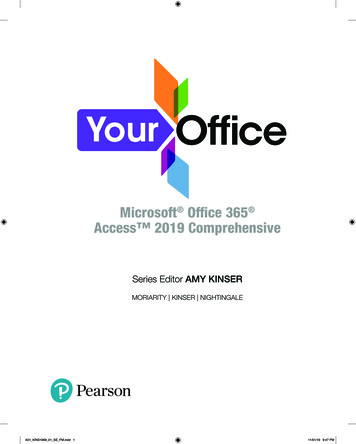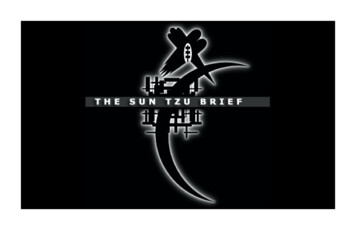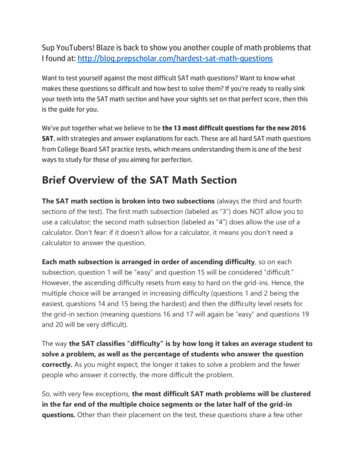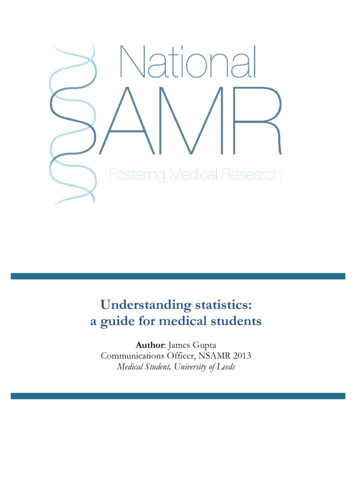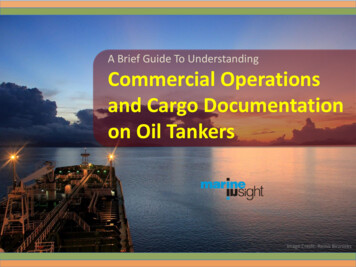
Transcription
A Brief Guide To UnderstandingCommercial Operationsand Cargo Documentationon Oil TankersImage Credit: Reinis Birznieks
AboutMarine Insight “A Brief Guide To Understanding Commercial Operations and Cargo Documentation On Oil Tankers”Publication date: March ’16Author: Nihar HerwadkarEditor : Raunek KanthariaPublished by: Marine Insight (www.marineinsight.com)Graphic Design: Anish WankhedeCopyright 2016 Marine InsightNOTICE OF RIGHTSAll rights reserved. No part of this book may be rewritten, reproduced, stored in a retrieval system, transmittedor distributed in any form or means, without prior written permission of the publisher.NOTICE OF LIABILITYThe authors and editors have made every effort possible to ensure the accuracy of the information provided inthe book. Neither the authors and Marine Insight, nor editors or distributors, will be held liable for anydamages caused either directly or indirectly by the instructions contained in this book, or the equipment, tools,or methods described herein.
About AuthorNihar Herwadkar has been with the A.P.MollerGroup since his cadetship. He is presently sailingas Chief Officer with Maersk Tankers and holds aMaster's COC from the UK.He takes active interest ingeopolitics and love readingnews articles and non-fictionbooks.Apart from playing with his 3year-old Labrador Retriever, agood part of his holidays backhome are spent playing squashand drinking scotch.He's also a member of theNautical Institute and a proudfreemason.www.marineinsight.com
INTRODUCTIONImage Credit: Alain BuitragoCargo Documentation on Tankers can be quite intimidating for theuninitiated. Tanker commercial operations are a cut-throat businessand maximising profits is the only manner in which one can stay aheadof the competition. A small mistake in tendering NOR or a wronglyworded protest can result in substantial loss of revenue. It is hence,very important to understand the jargon and know what documentsare required and when.To begin with, let’s briefly discuss what happens behind the scenesbefore the cargo is fixed one by one in following chapters:www.marineinsight.com
INDEX1. Finding Cargo and Fixing the Vessel2. Important Documentation at the Load Port3. Important Documentation for the Terminal4. Important Documentation For the Surveyor5. Letter of Protest (LoP)6. Important Documentation at the Discharge Port7. Glossarywww.marineinsight.com
Chapter 1Finding Cargo and Fixing the Vessel
Finding Cargo and Fixing the VesselIt all begins when the chartering department is trying to find cargo forthe vessel. Refineries and Crude terminals have cargoes to be shippedout on specific dates only. It is the Shipping Company’s CharteringDepartment’s responsibility to find a vessel which can best suit thecharterer’s requirements.The Chartering Team shortlists a vessel depending on her geographicallocation, size of the vessel and her current trade. This is when thevessel is sent out several questionnaires to fill up and with multiplestowage plan requests.While fixing the vessel, time is of the utmost essence and it isimperative that all queries and stowage plans are returned as swiftly aspossible. This could make the difference in a vessel winning or losingthe cargo.www.marineinsight.com
Finding Cargo and Fixing the VesselWhen drafting stowage plans it is vital that the intake is maximised. Arule of thumb is “More Cargo, More Freight”. Care should be taken toensure that bunker consumption, FW, Stores, un-pumpable ballast,tank washings, etc. are accurately accounted for.Image Credit: MarcOverestimation of these deductibles leads to a loss of cargo intake,while underestimating the deductibles can lead to overloading thevessel.Once a stowage plan is sent out, the vessel’s Master guarantees thathe can load the mentioned quantity provided that the density is eitherwww.marineinsight.com
Finding Cargo and Fixing the Vesselas mentioned in the stowage plan or more. There is no room for errorso understanding of the vessel’s sag and deducing a reasonableestimate of the constant is very important.When the charterer has in principle accepted a vessel for potentialtrade, it is said to be on Subs (which means subject to). Severalcompanies / brokers are usually vying for the same cargo and it is notuncommon for several vessels to be on subs at the same time for asingle cargo. Once the charterers have finalised on one vessel, it is saidthat the subs are lifted and that particular vessel is nominated for thecargo.Voyage Fixture, Charter Party and Voyage Orders The voyage fixture is generally sent out prior detailed voyage ordersand charter party abstracts. This will include a briefwww.marineinsight.com
Finding Cargo and Fixing the Vesselsnapshot with key details regarding the load port, cargo nominationand discharge port Detailed Voyage Orders and Charter Party abstracts aresubsequently sent out to all vessels. Any mismatch between theinitial voyage fixture and the voyage orders should immediately betaken up with the operationsBunker ROB and Cargo Tank Preparation After receipt of the fixture / voyage orders, it becomes the owner’sresponsibility to get the vessel ready to load the cargo. Havingsufficient bunkers and preparing the tanks are two vitalcomponents of this “responsibility”. For vessels on Time Charter,bunkers become the charterer’s responsibilitywww.marineinsight.com
Finding Cargo and Fixing the Vessel While preparing tanks, it should be borne in mind that the cargoshould be discharged in the same quantity and quality as wasloaded. Tank Preparations should be discussed with the NauticalDepartment and a Tank Cleaning plan drawn up Several reputed publications (Shell Tank Cleaning Guide, BP TankCleaning Guide, Dr. Vervey’s T/C Guide, etc.) are available that willgive specific guidelines on the methods to be utilised for tankcleaning. The company’s SMS should always be consulted priorcommencing operationswww.marineinsight.com
Chapter 2Important Documentation at the Load PortImage Credit: Jørgen Grindevoll
Documentation at the Load PortNotice of Readiness:After the “laycan” commences and the vessel is ready in all respects toreceive the nominated cargo, the Master is expected to tender aNOTICE OF READINESS indicating that his vessel is ready in all respectsto commence the loading of the said cargo. This is the single mostimportant document since the vessel starts earning freight from themoment the NOR is tendered. It is vital to understand specific clausesin the voyage orders pertaining Notice of Readiness.Two important points to remember before tendering the NOR are: Ship must be an arrived ship Ship must be ready in all respects to load / discharge the intendedcargowww.marineinsight.com
Documentation at the Load PortAs per most charter parties, a ship is considered to be an arrived shipafter she has reached the customary anchorage for the port.The NOR should be tenderedvia email / telex as well as byhard copy. The email shouldbe sent out immediatelyfollowing the actual NORtendering time.FREE PRATIQUE:Image Credit: Anil SamotraFree Pratique is a French term which means “permission granted to aship to have dealings at a port”. The requirement for Free Pratique is arelic of the past which most modern ports have done away with.www.marineinsight.com
Documentation at the Load PortAll necessary information is exchanged prior arrival port via email andvhf. However, some ports still continue the practice of not grantingfree pratique on arrival.Achieving Free Pratique becomes the owner/master’s responsibilityand the charterers can deduct laytime if the vessel is not granted freepratique on arrival (generally the NOR tendering time).Hence, it is of utmost importance that if Free Pratique is not grantedon arrival, the Master promptly issues a Letter of Protest against thedelay in granting Free Pratique.This is the only way in which owners can safeguard their legitimateclaim for laytime. Generally, it is advisable to issue this Letter ofProtest as soon as the NOR is tendered.www.marineinsight.com
Chapter 3Important Documentation for the Terminal
Documentation for the Terminal (Loading Master) ISGOTT Ship / Shore Safety Checklist: A prudent Chief Officerwould have this document printed out and ready for the LoadingMaster.www.marineinsight.com
Documentation for the Terminal (Loading Master)Entering generic data such as location of Fire Plans etc. will save time.Ensure that all deck officers fully understand terms A (Agreement), P(Permission) and R (Repetitive) of the ISGOTT SSSCL.www.marineinsight.com
Documentation for the Terminal (Loading Master) Key (Pre-Transfer) Meeting: One of the vital documents that comesin handy in the event of incidents, disputes or demurrage claims.Ensure that key data such as Maximum Loading Rate, Sequence ofLoading, Shore / Ship Stop, Maximum Topping Off Rate, MaximumStarting Rate, Maximum M’fold Pressure, Line Displacementrequirements etc. Declaration of Security:This document is onlyrequired to be completed, ifthe Port of Call is a non-ISPScompliant port or if theVessel or Port are atdifferent Security Levels orif requested by the PFSO /CSO / Flag StateImage Credit: Buhanifwww.marineinsight.com
Documentation for the Terminal (Loading Master) Ballast Report / Ballast Exchange Form: It is the Master’sresponsibility to ensure that the vessel has exchanged ballast as perlocal rules and regulations.Usually, the agent provides information whether exchange isrequired. Generally, the sea areas where ballast exchange isrequired are found in the Ballast Exchange Plan (e.g. Red Sea,Persian Gulf, US Waters, North Sea, Black Sea, etc.).Some of the port officials in the Black Sea area are especiallyparticular about this document and scrutinize the form minutely.www.marineinsight.com
Chapter 4Important Documentation for the Surveyor
Documentation for the Surveyor OBQ Certificate prior Loading: Critical document prior loading ofcargo. Some vessels on crude trade follow a practice of showing asmall ROB prior loading which can nullify ROB at the discharge port.However, on Product Tankers, it is undesirable to have any OBQpresent especially, if cargo grade being loaded is different from theprevious cargo. Empty Tank Certificate: Similar to the ROB / OBQ certificate butwith a signed statement from the surveyor stating as under:www.marineinsight.com
Documentation for the SurveyorThe above document can prove to be beneficial in the event ofdisputes arising out of sampling Last 3 Cargoes and Tank Preparation Report: This document isgenerally requested by all Surveyors, especially on Product Tankers.Having it ready will save time and effort. Ensure that the tankpreparation details are in line with the company guidelines andrelevant Tank Cleaning publications Vessel’s Experience Factor (VEF): VEF is the quantity loaded ordischarged as measured on the vessel (Total Calculated VolumeRemaining On Board or On Board Quantity) divided by the Bill ofLading (shore delivered at loading). Correct computation of thequalifying and non-qualifying voyages is vital. Generally, the ship’smaiden voyage, STS operations and the first voyage subsequent toany major alterations are excluded. Inclusion of a minimum of 5www.marineinsight.com
Documentation for the Surveyorvoyages and a maximum of 20 voyages is the industry practicewhile calculating VEF Slops Certificate: A slopreport with a signaturefrom the Cargo Surveyorindicating the Volumes,Ullage and Interface of theSlops on board is animportant document.Some port authoritieschoose to cross-referenceentries regarding Slops inthe Oil Record Book (PartII) with the Slop Certificatewww.marineinsight.com
Documentation for the Surveyor Sample Witness Certificate: In the event of sampling disputes / offspec cargo, it becomes important to prove that the vessel hadsampled the Cargo upon the commencement of loading in thepresence of the cargo surveyorwww.marineinsight.com
Documentation for the SurveyorIf the vessel can prove that the first foot sample and the manifoldsamples are the same, then the owners’ interest are safeguardedagainst claims. Some surveyors may refuse to sign this document. Insuch cases, it should clearly be mentioned that the surveyorrefused to sign the document and a Letter of Protest Issuedaccordingly Seal Certificate: Some terminals/ Port Authorities require theCargo Surveyors to Seal theCargo Sea Chest and theOverboard Valve prior loading /discharging. A signed certificateclearly indicating the sealnumbers should be obtainedfrom the Cargo Surveyorwww.marineinsight.com
Documentation for the Surveyor Other miscellaneous documents: Crew List, Ship’s Particulars,Ballast Quantity Report, and Bunker Report are some of the otherdocuments that are required by Cargo Surveyors on a case by casebasiswww.marineinsight.com
Chapter 5Letter of Protest (LoP)Image Credit: Zura Kajaia
Letter of Protest (LoP)Before we list out the various protests that can and should be issued,let’s briefly discuss the difference between a Letter of Protest and aNote of Protest.A Note of Protest is a declaration by the Master made in the presenceof a notary, magistrate, consul officer or other authority declaring thatthe circumstances beyond his control have or may cause damage. Ithas much a stronger legal standing, e.g. Weather damage to ship orcargo.A Letter of Protest on the other hand, is simply a statement of factsissued by the Master to the concerning party.We will concern ourselves with only the Letters of Protest since NotingProtests is beyond the scope of this topic.www.marineinsight.com
Letter of Protest (LoP)The following are the Letters of Protest that need to be issued on acase by case basis: LoP for Delay in Granting Free Pratique: As discussed earlier, thisLoP is extremely important in safeguarding the owners interest inthe event of delay in granting free pratique. All laytime could be lostfrom NoR tendered time until the commencement of cargooperations if this protest is not timely lodged LoP for Delays during Berthing / Unberthing: There is a very fineline between the time that is on charterers account and the timethat is on owners account. For e.g. the time from NoR tendereduntil anchor aweigh is on charterer’s account.However, the time from Anchor Aweigh until Pilot Onboard andright until All Fast is on the Owners account and charterers arewww.marineinsight.com
Letter of Protest (LoP)entitled to deduct the laytime for this period. Similarly, aftercompletion, the charterers are entitled approximately 3 hours freeof charge for the documents (B/L, Cargo Manifest, QualityCertificate, Quantity Certificate etc.) to be on board. After thedocuments are on board, all delays are entirely on the ownersaccount. Hence, it is crucial to note down all delays and do yourbest to mitigate the delays which are in the vessel’s control. Issuethe LoP with remarks explaining the delays LoP for Ullaging while Rolling / Ullaging in Open Sea Conditions:These protests are more likely to be issued at Single Buoy Moorings(SBMs) or during STS operations than when the vessel is alongside aterminal. The rolling motion could give false Ullage resulting in asignificant difference between ship and shore figures. The protestsafeguards owners interest in the event of disputeswww.marineinsight.com
Letter of Protest (LoP) LoP for Slow Loading: This protest should be issued if the loadingrate is lesser than the ship’s maximum loading rate. Care should betaken to mention the max. Loading rate in the Pre-Transfer (KeyMeeting) between the Chief Officer and Loading Master. Anexplanation for the cause of the slow loading rate (eg: Less ChicksanArms offered, size of reducers offered, shore pumping capacity,etc.) should be indicated. Specific indication of the time isimportant (i.e., the time the vessel would have completed loadingwith full rate and the time actually taken) for demurrage calculation LoP for Short Loading: This protest should be issued if the finalloaded quantity (ship’s figure) is lesser than the vessel nominationas per Charter Party / Voyage Orders LoP for Free Water in Cargo: This protest is more important forCrude Oil Tankers than Product Tankerswww.marineinsight.com
Letter of Protest (LoP)Products loaded will generally be free of any free water. However,to safeguard owner’s interest, it is prudent to issue this protesteven if no free water is detected. The protest will generally have aremark “Insufficient time allowed for settling of water. This mayresult in an increase of the quantity of water observedsubsequently.” This comes in handy if nil water is detected at thecompletion of loading but water is detected later in the voyage LoP for B/L Quantity: Due to various reasons, the ship’s figure andthe B/L figure will never be the same. Hence, irrespective of thepercentage of difference, a protest should be issued after applyingthe VEF, indicating the difference in quantity and the percentage ofdifference LoP for B/L Issuance: This is a generic protest which follows up on adocument issued by the Master called “Notice of B/L” whichwww.marineinsight.com
Letter of Protest (LoP)instructs the terminal to issue a B/L incorporating the New JasonClause, Clause Paramount, Both to Blame Collision clause, etc.More often than not, these clauses will not be included in the B/Land hence this protest becomes a necessity.The above is not an exhaustive list of protests. For other incidents /issues, a general Letter of Protest can be issued with appropriateexplanation for the protest. (e.g. Damage to vessel structure, differenttables used, unsafe operations, etc.)www.marineinsight.com
Chapter 6Important Documentation at the Discharge PortImage Credit: Dilan Chathuranga
Documentation at the Discharge PortAt the discharge port, most of the documents remain the same exceptfor the wording.The following are the important documents which are vital forDischarge Ports: PUMPING LOG: Key document for Demurrage claims. It is veryimportant to maintain the Maximum Allowed Pressure at theManifold as discussed in the Pre-Transfer Meeting.Appropriate remarks should be entered regarding any slowdowns,stoppages etc. with reasons. In the event of disputes, thisdocument becomes vital in proving that the vessel had done all thatwas required from her side. This document should be signed by theLoading Masterwww.marineinsight.com
Documentation at the Discharge Port ROB Certificate / Dry Tank Certificate: One of the most importantdocuments after discharging. Any remaining RoB should beremarked as follows “ROB is un-pumpable by ship’s fixed pumpingsystem which are in good working order. “ This document is signedby the surveyor CARGO RECEIPT: The Receivers are required to acknowledge receiptof the cargo that has been discharged ashore. In case the receivers /loading master refuses to sign this document, an appropriate letterof protest should be issued LoP for Slow Discharge: Similar to the LoP for Slow Loading. ThisLoP should be issued if the maximum allowable discharge rate /pressure at manifold is less than the vessel’s maximum as indicatedin the Pre-Transfer Meetingwww.marineinsight.com
GlossaryLaycan: The time frame in which the Master should present his vesselready in all respects to load the nominated cargo. NoR shall betendered before the expiry of laycanLaytime: The time available to the charterer to load (or discharge) thechartered cargo free of additional cost over and above the freight paidto the ownerCharterer: The Hirer. The person (or usually a company) that hires thevessel for tradeFreight: The money payable by the charterer to the ship-owner forcarrying the cargo on the said shipVoyage Charter: A charter party contract where the vessel is hired forwww.marineinsight.com
Glossaryone single voyage. Bunkers in this type of charter party remain theShip Owner’s responsibilityTime Charter: A Charter Party contract where the vessel is hired for aspecific period of time. The Vessel, Master and Crew are placed at thecharterer’s disposal for the entire duration subject to certain clauses.Bunkers in this type of c/p become the Charterer’s responsibilityDemurrage: For lack of a better term, Demurrage is a penalty paid bythe charterer to the ship-owner for exceeding the laytime period inloading / discharging a shipDespatch: The exact opposite of Demmurage. This is the money paidby the shipowner to the charterer for loading / discharging the vesselearlier to the expire of laytime periodwww.marineinsight.com
GlossaryThis is generally done, when the vessel has a potential employmentopportunity available and the charterer will release the vessel uponthe payment. Legally, the charterer is entitled to retain the vessel untilexpire of the laytime periodOnboard Quantity (OBQ): This is the quantity on board prior loadingRemaining Onboard (ROB): This is the quantity remaining on boardafter discharging / part discharging a cargo. Any RoB at the dischargeport subsequently becomes OBQ at the Load ----If you have any question regarding a topic mentioned in the ebook orrelated to it, please ask us at – Marine Insight Forumswww.marineinsight.com
Checkout Premium eBooks for Maritime Professionalswww.marineinsight.com
on Oil Tankers Image Credit: Reinis Birznieks . . books. Apart from playing with his 3-year-old Labrador Retriever, a good part of his holidays back home are spent playing squash and drinking scotch. He's also

